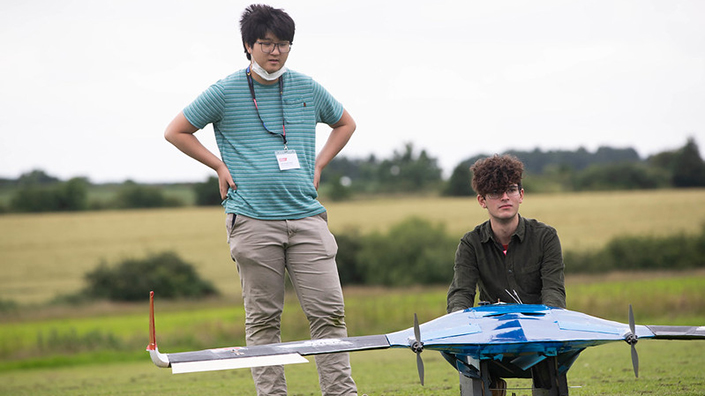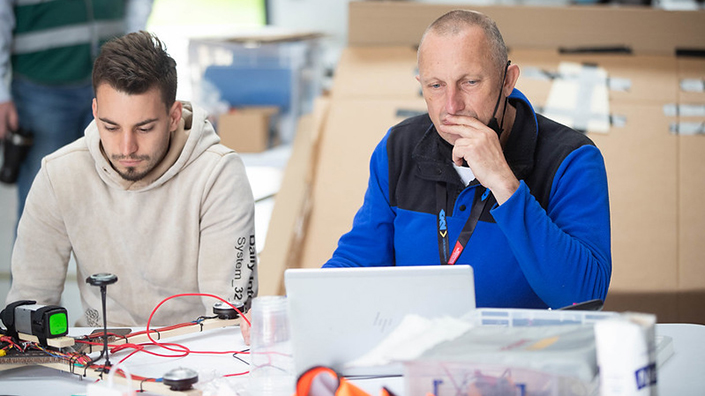Some pressure can be a good thing
In 2018, University of Surrey volunteer Oliver Gent watched as his university’s aircraft took off and promptly came back down again, managing to fly just one metre. Three years later, Gent is leader of Team Peryton, and he is determined to improve on previous performance.
Gent’s main takeaway from the competition is the ability to harness and work with pressure. Unlike theoretical university projects, he said the team’s designs simply “cannot be bad” – members need to be able to build it, and it needs to be able to fly. The practical aspect means much stricter deadlines and extensive flight preparations.
“Organisational skills are in a much higher-pressure situation than they would be otherwise,” he said. “Having the practical aspect to it really puts us under pressure to perform.”
Flying the team’s twin-engine aircraft in front of judges and other teams is “nerve-racking”, admitted team member Ryan Hewitt, despite a number of successful autonomous flights before the competition.
There was even more pressure after a dramatic crash on the final day. The autonomous plane took off very quickly, perhaps pushed by one of the many unpredictable gusts of wind at the BMFA Buckminster airfield in Lincolnshire, and banked immediately at the top of its climb. Losing height, and rapidly gaining speed, it briefly clipped the ground before barrelling over and landing upside down on the grass, losing parts as it came to a stop.
The aircraft was flying again just hours later, manually dropping a simulated humanitarian payload after some speedy repair work. The fix was possible thanks in part to a modular design approach, with wings, tail and fuselage all able to swap out if needed.
To overcome previous disappointments, Gent’s team took a ruthless approach. The aim was to prototype as early as possible and “get something to work”, he said, while also aiming for the highest number of points. “We’re not trying to do anything super-advanced, but we aim to win.”
The approach paid off – Team Peryton clinched the Grand Champion prize at the end of the event.
Flexibility is key
A shifting patchwork of international lockdowns during the Covid-19 pandemic meant flexibility was of supreme importance to both teams and organisers. With many unable to attend, the challenge became a hybrid event, with teams’ designs competing in simulation software as part of the virtual element.
“In an engineering career, things change all the time,” said UAS Challenge chairman Paul Lloyd. “You need to be flexible in what you’re doing, and your ability to adapt and change as the requirements change. Part of this challenge is to allow them to do that.”
Closing the event later that day, new IMechE chief executive Dr Alice Bunn said: “You all would have overcome hurdles to attend and compete, this year more than ever. I am convinced that the technologies of autonomous flight systems are the future of the industry, and you are at the forefront of this.”

Students assess their aircraft
‘Work the problem, persevere’
Excitement and anticipation among the Loughborough University team had a slight tinge of tiredness as members prepared for a final-day flight. Many of them were working until the early hours of the morning following a crash the previous day, fixing up the twin-boom, push-propeller Manta aircraft.
The team’s response shows the values of perseverance and problem solving, said member Ali Wasim. “I’ve been so proud of how everyone has responded to setbacks, of which we’ve had quite a few. But we’re one of five teams that have been able to get a plane here, so I’d say one of the main things I’ve taken away is just ‘Work the problem, figure it out, persevere’.”
Just moments later, the Manta took off – and, again, crashed within seconds. It did not matter though – thanks in no small part to the team’s persistence and calmness under pressure, they picked up five of 13 awards on the day, including runner-up, innovation, design and safety.
Don’t delay for other people

Aron Benke (left) and supervisor Dr Steve Wright
If you join an aerospace giant such as Airbus, Boeing or Lockheed Martin, you might expect a certain degree of anonymity among thousands of colleagues. Joining a start-up can be a very different experience, however, with fewer people to hide behind and greater responsibility to get things done.
Aron Benke will likely stand in good stead when he leaves university to work at a Hungarian start-up developing an electric manned aircraft. His team, from the University of the West of England, faced severe time pressures owing to the Covid-19 lockdown and only finished building their quadcopter four days before the competition.
Working under such pressure showed the value of doing things for yourself, said Benke. Unable to rely on others to provide parts on time, he found himself building the aircraft at home.
“We didn’t have access to the labs, but I managed to build a truss rig in my bedroom,” he said. “I was actually learning a lot during that process since I was doing it myself.”
He added: “I learned that I should not wait for other people, because there were so many times that other people said ‘I’m going to get this done’… but they actually never did.”
The short timeframe “was a really interesting exercise in showing what you can do,” said team supervisor Dr Steve Wright. “It’s the lesson you learn from aerospace in general – you go with what you’ve got, you don’t give up.”
It’s all about the process

IMechE president Peter Flinn and chief executive Dr Alice Bunn
Ultimately, it almost does not matter if an aircraft does not fly. That might sound like an unusual statement at a competition centred around designing, building and operating a drone, but judge Laurence Baron said the challenge has done its job if a team throws itself into the process, appreciates what it needs to do and works through all the disparate elements properly.
“Today is the combination of eight months’ worth of effort by all the teams, starting from the concept phase, right the way through formal preliminary and critical design reviews, and then flight readiness reviews,” he said.
“It’s appreciation for the students of that process, which we use throughout engineering – to get from a concept to something that literally flies… It’s the process, the lifecycle of a product, that they’re going to have to follow, whichever branch of engineering they go into.”
IMechE president Peter Flinn summed it up: “The iterative process that you have to go through quickly to get a product that works, that’s what engineering is all about. Whatever field of engineering you’re in, whether you’re making tin cans or aircraft, that’s the essence of it.”
Join IMechE and Professional Engineering at THE virtual fair for early engineering careers and find your perfect job! Register for EngRec 2021 FREE today.
Content published by Professional Engineering does not necessarily represent the views of the Institution of Mechanical Engineers.